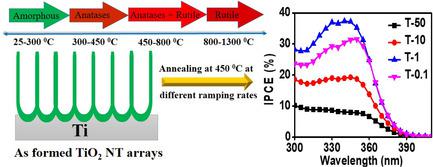当前位置:
X-MOL 学术
›
Phys. Status Solidi A
›
论文详情
Our official English website, www.x-mol.net, welcomes your
feedback! (Note: you will need to create a separate account there.)
Thermal Ramping Rate during Annealing of TiO2 Nanotubes Greatly Affects Performance of Photoanodes
Physica Status Solidi (A) - Applications and Materials Science Pub Date : 2021-04-07 , DOI: 10.1002/pssa.202100040 Waseem Raza 1 , Imgon Hwang 1 , Nikita Denisov 1 , Patrik Schmuki 1, 2, 3
Physica Status Solidi (A) - Applications and Materials Science Pub Date : 2021-04-07 , DOI: 10.1002/pssa.202100040 Waseem Raza 1 , Imgon Hwang 1 , Nikita Denisov 1 , Patrik Schmuki 1, 2, 3
Affiliation

|
Herein, highly ordered TiO2 nanotube (NT) arrays on a Ti substrate is synthesized in a fluoride-containing electrolyte, using the electrochemical anodization method, which yields amorphous oxide tubes. The effects of different thermal annealing profiles for the crystallization of the amorphous TiO2 NTs are studied. It is found that the temperature ramping rate has a significant impact on the magnitude of the resulting photocurrents (incident photon-to-current conversion efficiency [IPCE]) from the tubes. No appreciable changes are observed in the crystal structure and morphology of the TiO2 NTs for different annealing profiles (to a constant temperature of 450 °C). The electrochemical properties of the annealed TiO2 NTs are investigated using intensity-modulated photocurrent spectroscopy (IMPS), open-circuit potential decay, and Mott–Schottky analysis. The results clearly show that the annealing ramping rate of 1 °C s−1 leads to the highest IPCE performance. This beneficial effect can be ascribed to a most effective charge separation and electron transport (indicating the least amount of trapping states in the tubes). Therefore, the results suggest that controlling the annealing ramping rate is not only a key factor affecting the defect structure but also a powerful tool to tailor the physical properties, and photocurrent activity of TiO2 NTs.
中文翻译:

TiO2 纳米管退火过程中的热升温速率极大地影响了光阳极的性能
在此,在含氟化物的电解质中,使用电化学阳极氧化方法合成了 Ti 衬底上高度有序的 TiO 2纳米管 (NT) 阵列,从而产生无定形氧化物管。研究了不同热退火曲线对非晶TiO 2 NTs结晶的影响。发现温度上升速率对管产生的光电流(入射光子到电流转换效率 [IPCE])的大小有显着影响。对于不同的退火曲线(450°C 的恒定温度),在 TiO 2 NTs的晶体结构和形态中没有观察到明显的变化。退火态TiO 2的电化学性能使用强度调制光电流光谱 (IMPS)、开路电位衰减和莫特-肖特基分析来研究 NTs。结果清楚地表明,1°C s -1的退火升温速率导致最高的 IPCE 性能。这种有益效果可以归因于最有效的电荷分离和电子传输(表明管中的俘获态数量最少)。因此,结果表明,控制退火升温速率不仅是影响缺陷结构的关键因素,而且还是调整 TiO 2 NTs的物理性质和光电流活性的有力工具。
更新日期:2021-04-07
中文翻译:

TiO2 纳米管退火过程中的热升温速率极大地影响了光阳极的性能
在此,在含氟化物的电解质中,使用电化学阳极氧化方法合成了 Ti 衬底上高度有序的 TiO 2纳米管 (NT) 阵列,从而产生无定形氧化物管。研究了不同热退火曲线对非晶TiO 2 NTs结晶的影响。发现温度上升速率对管产生的光电流(入射光子到电流转换效率 [IPCE])的大小有显着影响。对于不同的退火曲线(450°C 的恒定温度),在 TiO 2 NTs的晶体结构和形态中没有观察到明显的变化。退火态TiO 2的电化学性能使用强度调制光电流光谱 (IMPS)、开路电位衰减和莫特-肖特基分析来研究 NTs。结果清楚地表明,1°C s -1的退火升温速率导致最高的 IPCE 性能。这种有益效果可以归因于最有效的电荷分离和电子传输(表明管中的俘获态数量最少)。因此,结果表明,控制退火升温速率不仅是影响缺陷结构的关键因素,而且还是调整 TiO 2 NTs的物理性质和光电流活性的有力工具。











































 京公网安备 11010802027423号
京公网安备 11010802027423号